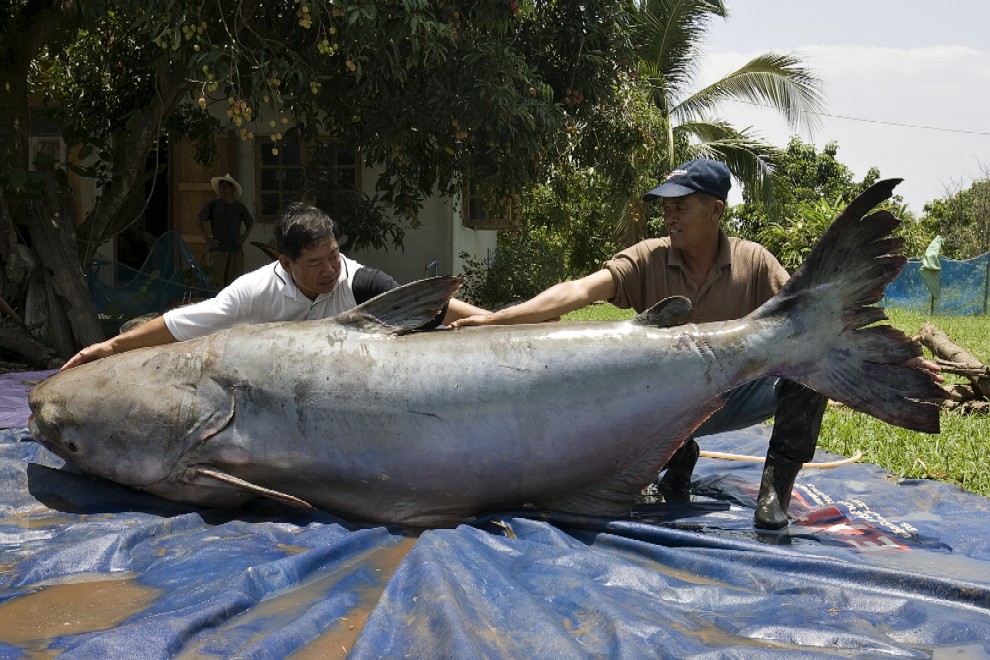 MECKLENBURG COUNTY, Va. — Talk to fishermen here, and you will hear the legend of Buggs Island Lake: A Navy diver sent to recover the wreckage of a small plane encounters a fish the size of a man on the lake’s bottom. He bolts to the surface and refuses to dip a toe in the waters again.
MECKLENBURG COUNTY, Va. — Talk to fishermen here, and you will hear the legend of Buggs Island Lake: A Navy diver sent to recover the wreckage of a small plane encounters a fish the size of a man on the lake’s bottom. He bolts to the surface and refuses to dip a toe in the waters again.
The yarn seemed as dubious as any other fish tale — until two weeks ago. An angler hooked a 143-pound blue catfish in this reservoir along the
It is likely not the only one lurking out there. A monster fish that can easily top 100 pounds and stretch nearly five feet has come of age in the region’s waterways.
It has a distended beer gut of a belly, a chin studded with whiskers tipped with taste-bud-like sensors and a grunt like a pig’s. Like a creature from a Hollywood B-movie, it has grown fat from conditions created by pollution.
Blue catfish have exploded in numbers and size in many local river systems, biologists say, spawning the type of giant fish more commonly found in the species’ native Mississippi River — or in the pages of Mark Twain. And no one is sure how big they’ll get here.
The rise of “blue cats” has spurred a response as strange as any fish story. Nearly everyone agrees it is a monster of sorts, but whether that is necessarily a bad thing depends on whom you talk to.
Many biologists are increasingly alarmed at the spread of the species, which they fear may be muscling out native catfish and gobbling up other local fish. The top predator has been described as the Bengal tiger of local rivers.
It is that size and fierceness that has made the blue cat a hit with anglers, who have flocked to southern Virginia waterways, generating tourism dollars for struggling rural areas.
“A lot of people love it. A lot of people hate it. It’s kind of like the snakehead,” said John Odenkirk, a Virginia state biologist, referring to another invasive species of fish that has captured the public’s imagination.
Buggs Island Lake, at 50,000 acres and with depths of up to 100 feet, is a good place for a monster to lurk. Nick Anderson was fishing there with his brother and father June 18 when he got the hit on his line.
“I got real nervous,” said Anderson, after he saw the lumbering gray mass. “It took about 50 feet of line and went straight down to the bottom.”
Over the next 45 minutes, Anderson, 29, a high school football coach from North Carolina, battled the blue cat until he was exhausted. Four times he reeled it to the surface, and four times it dove back into the depths of the lake.
Finally, he got it to the side of the boat. His father netted the fish, but the net was only big enough to cover the beast’s head, so Anderson grabbed the fish’s torso and his brother got hold of the tail. They wrenched it on board.
A place at the top
The blue catfish is, in part, a monster of our own creation. Virginia first stocked the fish in the James and Rappahannock rivers in the 1970s for sport fishing. By the late ’90s, the fish was showing up in large numbers in the Potomac River. Today, populations of various sizes are in Chesapeake tributaries around the region.